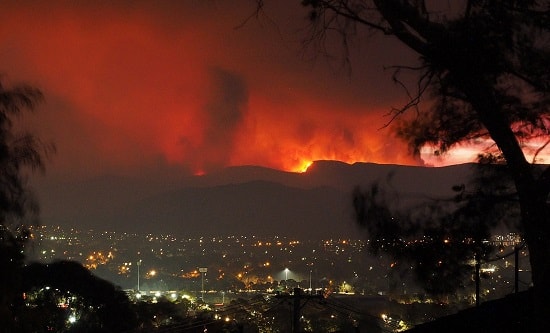
Since June 2019 Australia has experienced its worst bushfire season on record. At the time of writing 32 people have been killed and as of 24 January 2020, 77,000km2 – an area the size of Scotland – has been burnt in the most populated regions. 5,900 buildings have been destroyed, including 2,700 homes. Entire ecosystems have been destroyed, with an estimated one billion animals killed – a figure that excludes fish, frogs, bats and insects. The fires have released 900m tonnes of carbon dioxide into the atmosphere, twice the country’s annual emissions from other sources and equivalent to the annual emissions of 116 of the world’s lowest-emitting countries. SAM VINCENT reports.
What caused the fires?
Wildfires are an annual occurrence in Australia. Particularly dry conditions combined with abundant vegetation have resulted in previous extreme wildfire seasons, most notably in 1967 and 1974. The difference this year is how prolonged the fires have been, and how much they have affected residential areas.
2019 was Australia’s hottest year on record, with an annual average temperature of 23.5 degrees Celsius, 1.52C above the 1961-90 average. There is scientific consensus that longer periods of extreme heat make wildfires more likely and more prolonged.
Corruption and denial
Despite this, Australian politicians have denied the role of climate change as they try to divert attention from Australia’s atrocious record on the environment.
Australia is the world’s second largest coal exporter – producing half of global coal exports at a value of AUS$67bn in 2018-19 – and in 2020 overtook Qatar as the top exporter of liquified natural gas (export value AUS$49bn). Overall it is the third largest fossil fuel exporter after Russia and Saudi Arabia. The government is in hock to the mining companies that have driven GDP growth in Australia over the last two decades.
Over the past decade the Australian mining lobby has defeated any attempt at regulation of the industry, most notably the carbon pricing system, which became law in 2012 after five years of debate and watering-down. It was repealed just two years later after pressure from the mining industry.
Australian mining companies spent £2.7m on lobbying in 2018 alone and there is a ‘revolving door’ between the mining sector and the government. For example, Brendan Pearson, a current Senior Adviser on Trade and Investment, is former chief executive of the Minerals Council of Australia. Former Labor Party Prime Minister Kevin Rudd recently stated,
‘Glencore, Rio [Tinto] and BHP ran sophisticated political operations against my government, both on climate change and the mining tax. They worked hard … to get rid of the resource super profit tax … They worked hard … in 2013 against the carbon price. They succeeded in both enterprises.’

Protesters in Brisbane condemn Prime Minister Scott Morrison
Current Prime Minister Scott Morrison of the Liberal Party has downplayed the role of climate change as a contributing factor in the fires, blaming environmental groups for blocking preventative controlled burning of forested areas (this was subsequently disproved). In November, Deputy Prime Minister Michael McCormack called anyone linking the fires with climate change ‘inner-city raving lunatics’. Morrison faced widespread derision for choosing to continue his family holiday in Hawaii despite the fires reaching residential areas. On 10 January tens of thousands protested in cities across Australia demanding ‘ScoMo [Scott Morrison] has to go’ and calling for urgent action on climate change.
Australia’s record on the environment
Australia has the 13th highest greenhouse gas (GHG) emissions in the world and per capita emissions at three times the global average. When coal and petroleum exports are accounted for, Australia produces 5% of global emissions.
Australia has pledged to reduce its domestic GHG emissions by 26-28% by 2030 over 2005 levels. However, the watchdog Climate Action Tracker estimates that, based on current policies, the actual reduction will be only 7%, while GHG emissions from industry and energy sectors are currently increasing at around 1% per year. As a result, Australia is ranked sixth worst out of the 60 countries on the annual Climate Change Performance Index.
Wake-up call
The Australian bushfires are just one example of the consequences of extreme weather conditions that will become increasingly common as the climate crisis intensifies.
FRFI is clear that this crisis is not caused by individuals, but by a relatively small number of companies seeking returns on the vast sums of capital invested in them. A staggering £1.9 trillion has been invested globally in fossil fuel companies since 2015 alone, and direct government subsidies of fossil fuels total £284bn annually.
Capitalist governments like Australia’s exist to defend this system, so they cannot be a vehicle for the kind of change that is necessary. A rational response to the environmental crisis will only be brought about by a movement that is ready to confront the criminal companies and the banks that invest in them.
Sam Vincent
Fight Racism! Fight Imperialism! No 274, February/March 2020




